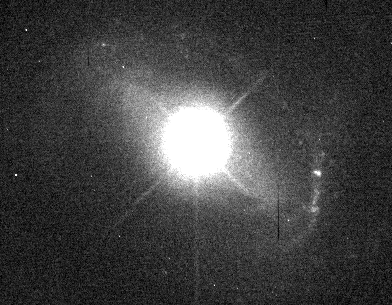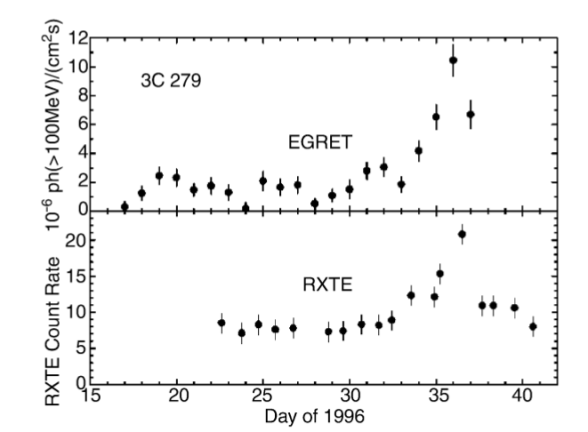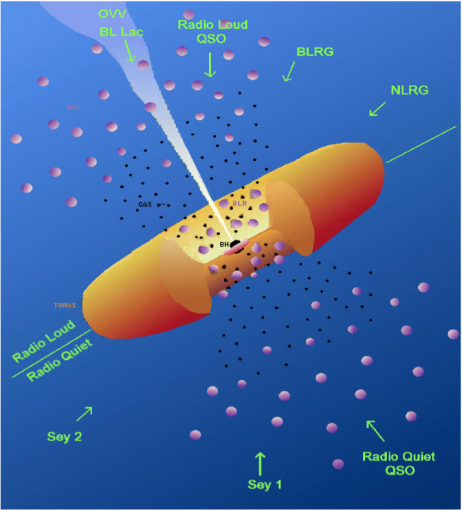A long time ago, in a galaxy
far far away…
The central super massive black hole had lured a large amount of
gas on to itself to enable the restart of the accretion mechanism, thereby
beginning to emit copious amounts of energy out into the universe,
the likes of which is possible through very few other process and is
thus seldom seen in the universe. In fact, it was so luminous, that it
was observed by a species who call themselves as humans, living on a
small blue planet they call the Earth. The story of how the humans studied
and understood this phenomena is a nice story, worthy of atleast one telling.
The emission from this galactic nuclei, was at first thought to be a nebula (the term which humans use to describe interstellar gas and dust) by the humans, but at this time, they were pretty much limited in the technology they possessed to view and study such phenomena accurately. The person who first observed this event was called Pierre Mechain, who was the one who classified it as a nebula, and passed this information to a fellow human Charles Messier who was making a catalogue of such astronomical sources. This object, thus came to be known as Messier 77, or just M77 (though in more recent catalogs, this object is also referred to as NGC 1068). Messier, being slightly smarter, classified this object as a star cluster, which was also backed up by another renowned astronomer of the day, William Herschel. When humans launched their space telescope, christened Hubble Space Telescope, they took the following image of M77. However, proper attention began to be given to this phenomena in the years
from 1900 onwards in the Earth calendar. This was accentuated when earthlings began to do spectroscopic measurements of astronomical sources, which involves resolving the light coming from these stars into various frequency bands in the electromagnetic spectrum. They observed that this particular source exhibited strong and broad emission lines in its spectrum, much much higher than those exhibited by other sources. This is how they distinguished such sources from other ordinary sources. Thus, based on this criteria, and many others as well, humans found a method to classify such sources into different categories, which we will now investigate. Based on the position of these objects in their galaxies, these objects were collectively coined as Active Galactic Nuclei, or AGNs. (To read about how these supermassive black holes produce energy, read this article written by the same earthling who is publishing this article on our behalf: Accretion disks and accretion mechanism )
The first category they created was based on the band of frequency that is visible to the human eye, i.e. from 400 nm to 700 nm. Many quasars observed in the optical domain had an unusually blue color. This prompted them to look for such objects with a very blue (U – B) color index. These however, showed a pronounced “quietness” in the radio domain in the electromagnetic spectrum. Thus, the label of radio quiet quasars, or quasi-stellar objects (QSOs) fell to these objects. However, it turned out that these radio quiet objects do also emit in the radio domain, which is detected when the instruments used for detection are sensitive enough to detect it. Thus, nowadays, humans use the term QSO to cover both radio-quiet QSOs and quasars. Incidentally, QSOs are the most luminous objects observed in the universe, often outshining the host galaxies by factors as high as a thousand. Thus, QSOs appear as point sources in optical images.The QSOs with lower luminosities than above were spotted and resolved using the Hubble space telescope (HST).
The next category of AGNs is what is called Seyfert Galaxies. These objects are much less luminous than the QSOs. On optical images, these appear as spiral galaxies with exceedingly bright cores, exhibiting the characteristic strong and broad emission lines. Seyfert galaxies can be distinguished further into two base categories, Seyfert 1 and Seyfert 2. Seyfert 1 galaxies exhibit both broad and narrow emission lines in their spectrum. Seyfert 2 galaxies, on the contrary exhibit only the narrower emission lines, but these “narrow” lines are much broader than those exhibited by normal galaxies. However, there are galaxies lying in between as well, such as for example Seyfert 1.3 or Seyfert 1.8, which exhibit broader emission lines but which are much less prominent than those exhibited by the Seyfert 1 galaxies. The M77 above is an example of a Seyfert galaxy. The illustration of such narrow and broad lined galaxies is given in the figure below:

Seyfert 1 : NGC 1275 Exhibits both narrow and broad emission lines in the optical spectrum of 1275. The lower panel is a zoom in of the upper panel to show some of the finer features.

Seyfert 2: NGC 1667
Strong narrow emission lines are observed, along with absorption lines of the host galaxy
The next category devised was of Radio Galaxies. This category consisted of elliptical galaxies with an active nucleus. In an analogous manner to the Seyferts, these are also sub-divided into two categories, namely broad line radio galaxies (BLRG) and narrow line radio galaxies (NLRG) based on the observed width of the emission lines. In principle, the two types of radio galaxies can be thought of as the radio-loud versions of the Seyfert counterparts, but with a different morphology of the host galaxy. Apart from this optical classification of the radio galaxies, they are also classified on the basis of their radio morphologies, i.e. based on the FR1 and FR2 criteria.
On careful observations, humans noticed that some of the QSOs exhibited extreme variation in their optical luminosities. These luminosities can vary violently over a period of just a few days. This led to their labeling as Optically Violent Variables (OVVs). Besides this, these objects showed polarization in the detected optical radiation, usually of a few percent (whereas normal QSOs exhibited below 1%). OVVs are also strong radio emitters, and their radiation in other bands also varies strongly, with the amplitude increasing and time-scale decreasing as one moves to the higher end of the frequency spectrum.
Another peculiar class of AGNs observed exhibited a similar variability as OVVs, but failed to exhibit any strong emission and absorption lines. These objects are called as BL Lacs, in honor of the prototype the humans found in the source BL Lacertae. BL Lacs also exhibit polarization in their radiation, analogous to OVVs. The optical luminosity of BL Lacs can vary by several magnitudes if observed over sufficiently long intervals. Also, humans noted that if observed in the epochs of low luminosity, emission lines are sometimes observed, and thus BL Lacs appear to be OVVs. Hence they have now taken to calling BL Lacs and OVVs together as blazars. All blazars are radio sources. Blazars also show highly energetic and strongly variable . An example of this variability is shown in the following figure; it shows the variability of 3C279 in X-ray and
, with photon energies above 100 MeV. Notice that on a timescale of a few days, the luminosity varies by approximately 10.
But, after all this hullabaloo over the different classification schemes, things were going to be massively simplified for the humans. Upon deeper analysis of the phenomena, it was understood that all the different types of the observed AGNs are a symptom of the angle at which these sources are viewed. This idea is clearly illustrated by the following figure:
What the human “physicists” learned that the structures around the central black hole play an important part in what type of AGN is observed. The central super massive black hole was estimated by them to be surrounded by, along with an accretion disk, a dusty torus, as shown in the figure. It also turned out that quite a few AGNs were accompanied by a “jet” which consisted of very highly energetic charged particles, accelerated to velocities near to that of the speed of light. These jets can be “one-sided” which renders the opposite side with a spectrum of subdued luminosity.
When viewed from this “weaker” side, we get the Seyfert and radio quiet QSOs. In a similar manner, depending on the viewing angle different classes of AGNs are obtained, which is nicely represented in the diagram.
Thus, the efforts of many humans
culminated in their proper understanding
of the phenomena called as AGNs.
And the story goes on as humans
try to understand many such phenomena
surrounding them ………………….
Sources:
Extragalactic Astronomy and Cosmology – Schneider
NASA, NRAO
Wikipedia






